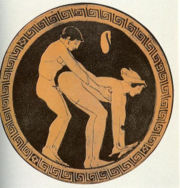Immigrant child
I love summer. The sun, the flowers that make the air smell so beautiful, the long days, the happy people. The good memories I made as a child spending every summer in Italy with my Italian family, playing in the streets until late at night is still a vivid part of my life. As a child, I spend every summer in Italy. As soon as school was out my dad and I took the train to Bari, which is in South Italy. It was the longest train ride ever. The train was full with Italians and all the stuff they took home to their families. Even today, I believe that every Italian who lived in Germany took the train home for the summer. This was not one of these modern ICE (fast) trains, no it was one of these old trains that had several compartments in one wagon, and each compartment fit six people. Even though, I did not particularly like the train ride I was never bored. There were always enough kids to hang out with.
The train ride suppose to take 24 hours from Bensheim/Germany to Bari/Italy. While in Germany, the train was always on time. But once the train crossed that Italian border it was delayed, and I am not talking 5 minutes late more like 5 hours late.
Eventually, we made it to Bari and at the train station the whole family waited to greet us. It was a loud and happy welcome just like in Italian movies. And because so many of the family members came to the station, the car ride back to my dad’s hometown was always uncomfortable. I was squeezed in the back seat between my cousins and the luggage was squeezed between us. I could hardly breath it was so tight, but I sure was happy.
Each year when we first arrived at the street where my family lived, I saw Nonna (my dads mom) sitting on a chair in front of her house making pasta. She was often outside, sitting on a woven chair on the sidewalk with the neighbor women working, talking, and laughing. As long as I remember, her hair was white and pulled back in a tiny bun. He name was Brudencia, she never spoke much to me (probably because of my lack of Italian) but I had great respect. But do not get the wrong idea, she was not the quiet type, more the loud-yelling, everyone listening- still very kind type. And even when she was in her nineties and her body showed signs of severe aging her voice and mouth was still in her mid twenties.
When Nonna was not outside she was in the kitchen preparing food. On a large wooden board she made the worlds best Cavatelli Pugliese, a local pasta. On the board she rolled the pasta dough into a one cm thick snake then cut a tiny piece of and rolled it over her thump. Of course she repeated that step many times to make enough pasta for everyone.
Nonna always had the girls of the family help in the kitchen, and all of the meals were made from scratch and it took hours of hard work to prepare food. When I close my eyes and concentrate, I can still smell all the delicious foods; see the table set up; my whole family sitting, eating and laughing around the table. Sometimes for dessert my dad cut up a juicy, fresh peach in little bite size pieces and put it in a glass and poured red wine over it. I was aloud to eat the peach that was soaked full of wine and tasted like sunshine. But, I was not allowed to drink the wine, not even a zip!
Once a week Nonna and I went to the local farmers market where she bought all kinds of seasonal foods: fish, fruits, veggies, and my favorite Italian salami. For breakfast, I often ate a slice of thick Italian bread and a slice of the world's best salami. I recall asking my dad why he did not buy some of that yummy salami to take back home, he answered he could not. It would take several more years before I learned why not. The salami was illegal in Germany! No, I am not kidding. But let me start from the beginning. During one of these Italian summers, I must have been 15 years old, Nonna sent me to the farmer’s market to get a couple of things she needed. I walked to the market where they sell the salami, and while I stood in line I read the label that was in front of the delicious salami. Salame di Cavallo stood there on the sign!!! For all those who do not speak Italian, it means HORSE SALAMI!!! First I felt shocked and then my mind sent me into a different dimension of disgust. I almost threw up! My stomach turned in ways I did not know was possible. Instantly, I turned around and ran back to Nonna’s house, where I found my dad in front of the house having an espresso. After telling him what I just read he laughed out loud so loud that the neighbor came out to see what was going on. Between his laughing my dad muttered: “so what…. it is meat.” I replied no, it is horse! He laughed horse, cow what’s the difference? Even then I knew it was just a rhetorical question.
Now as an adult, I understand his point. It was the food of his culture, of his home. They ate horse and it was normal. I still do not agree, but I understand. Back then, I felt sick for days. It took me a while to eat the normal kind of salami again, but even today I have a somewhat disturbed relationship with salami.
The train ride suppose to take 24 hours from Bensheim/Germany to Bari/Italy. While in Germany, the train was always on time. But once the train crossed that Italian border it was delayed, and I am not talking 5 minutes late more like 5 hours late.
Eventually, we made it to Bari and at the train station the whole family waited to greet us. It was a loud and happy welcome just like in Italian movies. And because so many of the family members came to the station, the car ride back to my dad’s hometown was always uncomfortable. I was squeezed in the back seat between my cousins and the luggage was squeezed between us. I could hardly breath it was so tight, but I sure was happy.
Each year when we first arrived at the street where my family lived, I saw Nonna (my dads mom) sitting on a chair in front of her house making pasta. She was often outside, sitting on a woven chair on the sidewalk with the neighbor women working, talking, and laughing. As long as I remember, her hair was white and pulled back in a tiny bun. He name was Brudencia, she never spoke much to me (probably because of my lack of Italian) but I had great respect. But do not get the wrong idea, she was not the quiet type, more the loud-yelling, everyone listening- still very kind type. And even when she was in her nineties and her body showed signs of severe aging her voice and mouth was still in her mid twenties.
When Nonna was not outside she was in the kitchen preparing food. On a large wooden board she made the worlds best Cavatelli Pugliese, a local pasta. On the board she rolled the pasta dough into a one cm thick snake then cut a tiny piece of and rolled it over her thump. Of course she repeated that step many times to make enough pasta for everyone.
Nonna always had the girls of the family help in the kitchen, and all of the meals were made from scratch and it took hours of hard work to prepare food. When I close my eyes and concentrate, I can still smell all the delicious foods; see the table set up; my whole family sitting, eating and laughing around the table. Sometimes for dessert my dad cut up a juicy, fresh peach in little bite size pieces and put it in a glass and poured red wine over it. I was aloud to eat the peach that was soaked full of wine and tasted like sunshine. But, I was not allowed to drink the wine, not even a zip!
Once a week Nonna and I went to the local farmers market where she bought all kinds of seasonal foods: fish, fruits, veggies, and my favorite Italian salami. For breakfast, I often ate a slice of thick Italian bread and a slice of the world's best salami. I recall asking my dad why he did not buy some of that yummy salami to take back home, he answered he could not. It would take several more years before I learned why not. The salami was illegal in Germany! No, I am not kidding. But let me start from the beginning. During one of these Italian summers, I must have been 15 years old, Nonna sent me to the farmer’s market to get a couple of things she needed. I walked to the market where they sell the salami, and while I stood in line I read the label that was in front of the delicious salami. Salame di Cavallo stood there on the sign!!! For all those who do not speak Italian, it means HORSE SALAMI!!! First I felt shocked and then my mind sent me into a different dimension of disgust. I almost threw up! My stomach turned in ways I did not know was possible. Instantly, I turned around and ran back to Nonna’s house, where I found my dad in front of the house having an espresso. After telling him what I just read he laughed out loud so loud that the neighbor came out to see what was going on. Between his laughing my dad muttered: “so what…. it is meat.” I replied no, it is horse! He laughed horse, cow what’s the difference? Even then I knew it was just a rhetorical question.
Now as an adult, I understand his point. It was the food of his culture, of his home. They ate horse and it was normal. I still do not agree, but I understand. Back then, I felt sick for days. It took me a while to eat the normal kind of salami again, but even today I have a somewhat disturbed relationship with salami.
anna25bell - 28. Mai, 22:08
8098 x

 The Greek writer Asclepiades writes of a prostitute named Hermione who wore a girdle embroidered with, "Love me always, but do not be jealous if others do as you do”(Vern38). In Athen, prostitutes used temporary body modifications to enhance their facial and body features as in stuffing their shoes with cork to appear taller, or use bustles to increase the size of their hips and breasts. Today’s women use wonder-bra’s to make their bosom look larger. That being said, it is safe to say that no woman in the western hemisphere will pad her hips to make them appear bigger. Here is an interesting thought" I am pretty sure no ancient prostitute would starve herself to death to be super-skinny either! Ancient prostitutes used a lot of make-up and layers of white lead, a lot of rouge, and soot to emphasize eyebrows. The effect was that prostitutes were easier to spot due to the fact that respectable Greek woman refused to paint their faces because they promoted a more natural looking face (Sherrow250). There, where not many sumptuary laws in ancient Greece, and the few the greeks had were not enforced. For instance, prostitutes had to dye their hair blond, which they did anyway, so they could distinguish themselves further from a boring housewife.
The Greek writer Asclepiades writes of a prostitute named Hermione who wore a girdle embroidered with, "Love me always, but do not be jealous if others do as you do”(Vern38). In Athen, prostitutes used temporary body modifications to enhance their facial and body features as in stuffing their shoes with cork to appear taller, or use bustles to increase the size of their hips and breasts. Today’s women use wonder-bra’s to make their bosom look larger. That being said, it is safe to say that no woman in the western hemisphere will pad her hips to make them appear bigger. Here is an interesting thought" I am pretty sure no ancient prostitute would starve herself to death to be super-skinny either! Ancient prostitutes used a lot of make-up and layers of white lead, a lot of rouge, and soot to emphasize eyebrows. The effect was that prostitutes were easier to spot due to the fact that respectable Greek woman refused to paint their faces because they promoted a more natural looking face (Sherrow250). There, where not many sumptuary laws in ancient Greece, and the few the greeks had were not enforced. For instance, prostitutes had to dye their hair blond, which they did anyway, so they could distinguish themselves further from a boring housewife.  (“Huren Tour”) one can see replications of a typical outfit worn by prostitutes in Hamburg during the late middle ages. The purpose of these restriction where to spot a prostitute quicker so one could discriminate against her, but in reality it helped potential customers to find a prostitute quicker. Either way, it worked for both parties. However, compared to other historical liberated women, during different time periods, prostitutes in the middle ages could not rise in class and become as popular as a Greek Hetaera. Prostitutes during the dark ages were for the most part restricted to certain areas and where not allowed to wear any luxury items. “In Bristol, England the hoods of prostitutes had to be made with a striped fur, different from the type worn by respectable women” (Vern124). In England, “the city of London, for example, specifically forbade prostitutes from ‘parading’ anywhere except in certain regulated districts,” and those women who did were thrown out of the city (Vern125). Laws banning prostitutes to brothels in designated areas, to prevent these women from rising in class. Every metropolitan area in Europe required prostitutes to live in a certain section of town and confined them in their activities. Most prostitutes lived in brothels, and if a prostitute serviced a customer outside that location she was confined to special quarters. Prostitutes who lived “in these quarters, wore clothes specified items such as armbands or other attire to distinguished them from respectable society matrons” (Vern 125).
(“Huren Tour”) one can see replications of a typical outfit worn by prostitutes in Hamburg during the late middle ages. The purpose of these restriction where to spot a prostitute quicker so one could discriminate against her, but in reality it helped potential customers to find a prostitute quicker. Either way, it worked for both parties. However, compared to other historical liberated women, during different time periods, prostitutes in the middle ages could not rise in class and become as popular as a Greek Hetaera. Prostitutes during the dark ages were for the most part restricted to certain areas and where not allowed to wear any luxury items. “In Bristol, England the hoods of prostitutes had to be made with a striped fur, different from the type worn by respectable women” (Vern124). In England, “the city of London, for example, specifically forbade prostitutes from ‘parading’ anywhere except in certain regulated districts,” and those women who did were thrown out of the city (Vern125). Laws banning prostitutes to brothels in designated areas, to prevent these women from rising in class. Every metropolitan area in Europe required prostitutes to live in a certain section of town and confined them in their activities. Most prostitutes lived in brothels, and if a prostitute serviced a customer outside that location she was confined to special quarters. Prostitutes who lived “in these quarters, wore clothes specified items such as armbands or other attire to distinguished them from respectable society matrons” (Vern 125).  The "ruling" Cortigianes of Venice became celebrated for their classical beauty, their conversational skills, and their intelligence. Estimates vary, but it is said that there were around 11,000 prostitutes servicing 300,000 venetian residents. With so many courtesans, it was tough for a man to tell the difference between a puttana and a married woman. The puttana, a lower class prostitute, was usually easier to spot. Some dressed like men wearing codpieces, and others wore dresses cut so low that it revealed more then it covered up. But most incredible of all, Venetian prostitutes wore shoes that would have intimidated
The "ruling" Cortigianes of Venice became celebrated for their classical beauty, their conversational skills, and their intelligence. Estimates vary, but it is said that there were around 11,000 prostitutes servicing 300,000 venetian residents. With so many courtesans, it was tough for a man to tell the difference between a puttana and a married woman. The puttana, a lower class prostitute, was usually easier to spot. Some dressed like men wearing codpieces, and others wore dresses cut so low that it revealed more then it covered up. But most incredible of all, Venetian prostitutes wore shoes that would have intimidated 